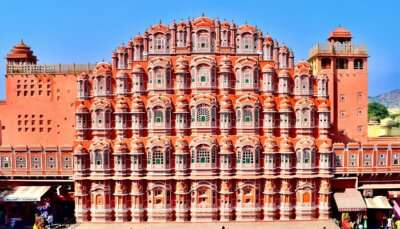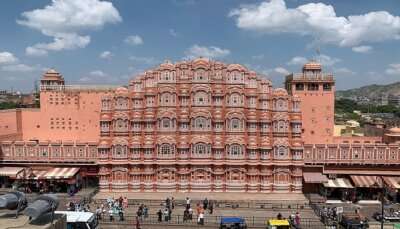Explore The Historical Journey Of Hadrians Gate In Antalya
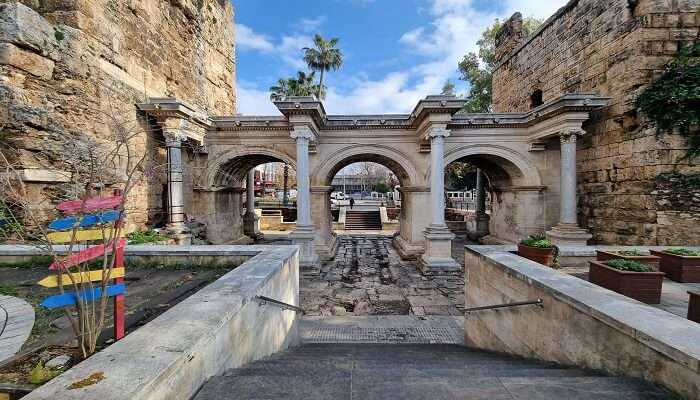
Hadrians Gate is a famous example of Roman architecture that serves as a reminder of the Roman Empire’s majesty and inventiveness. This magnificent gateway in the heart of Antalya in Turkey has captivated visitors for centuries with its imposing presence and intricate details. By passing through the magnificent Hadrian’s Gate, you can enter the historical records and discover the mysteries of a society that profoundly influenced the course of human history. Explore its elaborate design and be amazed by the Roman engineers’ inventiveness; every stone bears witness to the lasting influence of a bygone period.
About Hadrian’s Gate
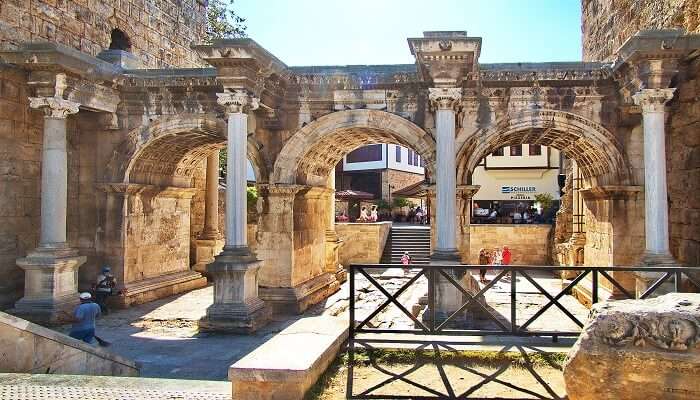
Hadrian’s Gate, also known as Üçkapılar (meaning “The Three Gates” in Turkish), is a majestic memorial arch in Antalya, Turkey. The Hadrian’s gate history dates back to 130 AD when it was built to honour the visit of Roman emperor Hadrian, the gate became an integral part of the city’s defensive walls and serves as the sole remaining entrance point today.
The Gate’s preservation is attributed to its long concealment behind city walls, only to be revealed after the walls’ collapse in the 1950s. A restoration in 1959 unveiled the original Roman walkway, visible through a transparent floor, bearing deep grooves from historical traffic. This monument, which is still an important historical and cultural site, is evidence of the Roman influence in the area.
Must Read: Monuments In Turkey
Hadrians Gate: Architecture And Design
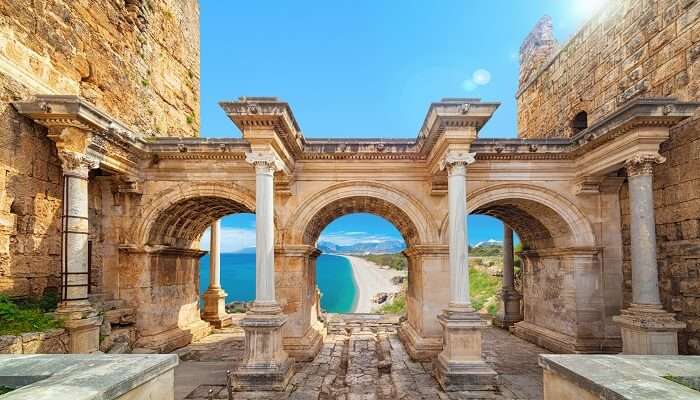
The gate showcases two majestic collonaded facades, each boasting three arches that ascend above four robust towers, standing tall at about 8 meters (26.2 feet). It is flanked by two historical towers: the Southern Tower or Julia Sancta, a relic of the Roman period, and the Northern Tower, which combines Roman foundations with a 13th-century AD reconstruction under Seljuk Sultan Alaeddin Keykubat I. The gate’s artistry is marked by its pristine white marble construction, save for the granite pillars. Three dome-like openings distinguish the upper section, while the passageways are embellished with elaborate floral and rosette carvings. An entablature stretches out atop the gate, standing 1.28 meters (4.2 feet) tall. It features a frieze adorned with botanical patterns and a lavishly detailed cornice with lion motifs, enhancing the gate’s aesthetic allure.
The gate’s foundation was excavated, and bronze letters, components of a tribute to Emperor Hadrian, were unearthed. These artefacts are now scattered across global museums and private collections, including nine in Vienna, two in Berlin, and others in the British Museum in London and the Ashmolean Museum in Oxford. The absent upper story is speculated to have borne another inscription, signifying the gate’s historical significance. Today, Hadrian’s Gate is a beloved monument that offers insight into the architectural ingenuity and cultural legacy of the Roman Empire. It continues to enchant onlookers with its grandeur and the narratives ingrained within its structure.
How To Reach Hadrians Gate
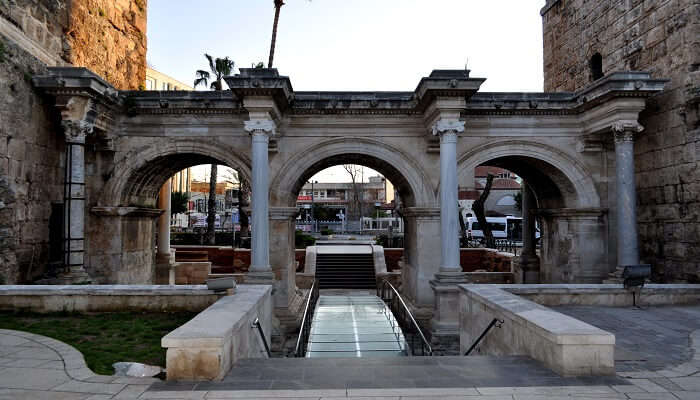
You have several convenient options for visiting Hadrian’s Gate from the Antalya city centre. They are as follows:
- By Bus: Board any bus heading to Antalya Otogar (Bus Terminal). Upon arrival, a short 15-minute walk will lead you to Hadrian’s Gate. Expect to pay approximately 3 Turkish Lira (TL), equivalent to $0.35 USD, for the bus fare.
- By Tram: Opt for the Antray tram service connecting Antalya Airport to Fatih station. Disembark at İsmetpaşa station, the nearest stop to Hadrian’s Gate. The tram ticket costs about 4 TL or $0.47 USD.
- By Taxi: Hail a taxi from any location within Antalya and request to be taken to Hadrian’s Gate. While fares vary based on distance and traffic conditions, they typically do not surpass 50 TL or $5.87 USD for a one-way journey.
- By Car: Consider renting a vehicle from the airport or the city centre. Drive yourself to Hadrian’s Gate and utilise the nearby parking facilities, which charge around 10 TL or $1.17 USD per hour for parking.
Suggested Read: Turkey In September
Interesting Hadrian’s Gate Facts
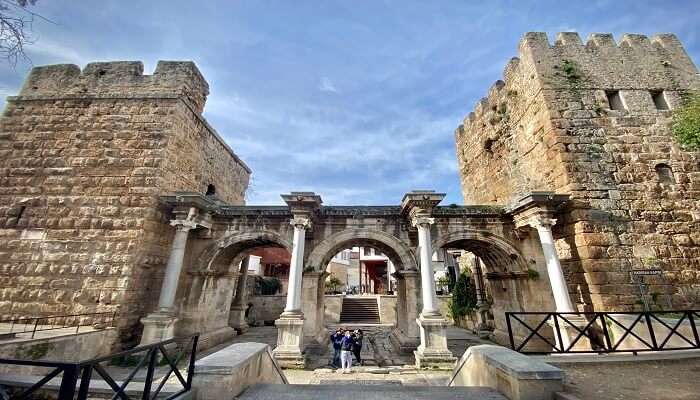
Some fascinating facts about this historical structure:
- Built-in HGate: Hadrians Gate was constructed to honor Emperor Gateian.
- Construction Date: The gate dates back to 130 AD.
- Unique Entrance: It is the sole surviving entrance gate in the ancient city walls.
- Twin Towers: Flanking generates two towers, each from a different historical period.
- Royal Passage: Legend has it that the Queen of Sheba passed beneath this gate.
- Rediscovery: In 1817, Francis Beaufort rediscovered Hadrians Gate.
Suggested Read: Mountains In Turkey
Best Time To Visit The Hadrian’s Gate?
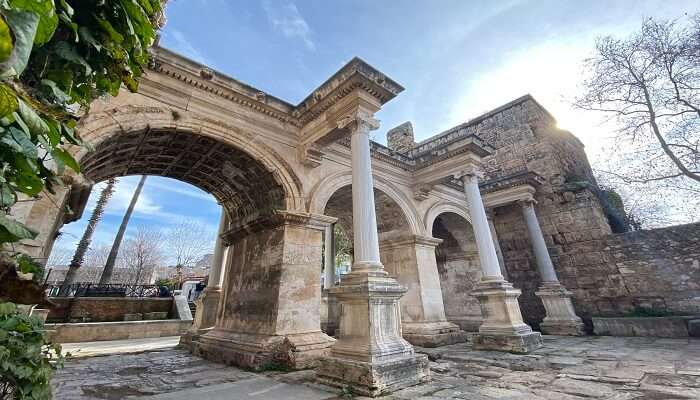
Hadrians Gate in Antalya welcomes visitors year-round, day and night. For an optimal experience, aim to visit between 5:00 p.m. and 9:00 p.m., when the setting sun casts a warm glow over the ancient stones. The gate’s magnificence is most striking during these hours.
Consider planning your trip between April and June or September and November for comfortable weather and fewer tourists. These months offer a balance of pleasant climate and lighter foot traffic, making it easier to enjoy the city’s lively charm and the gate’s historical splendour.
Nearby Places To Visit From Hadrians Gate
After visiting Hadrians Gate, you can also visit several nearby attractions. Some of the popular ones include the following:
1. Kaleici
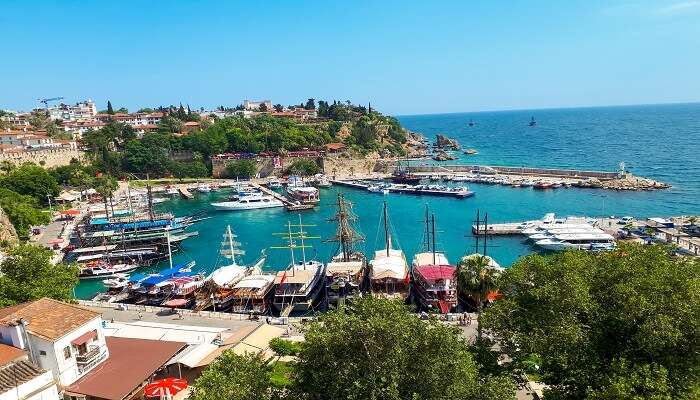
Kaleici, the historical heart of Antalya, Turkey, is a picturesque district that takes you back in time with its narrow cobblestone streets and Ottoman-era houses. Enclosed within ancient Roman walls is a cultural mosaic reflecting its diverse past, which includes Roman, Byzantine, Seljuk, and Ottoman influences. Today, it’s a vibrant neighbourhood boasting colourful traditional homes, boutique hotels, cosy cafes, and shops.
Location: Selçuk, 07100 Muratpaşa/Antalya, Turkey
Travel Time: 7 min
Suggested Read: New Year In Turkey
2. Antalya Museum
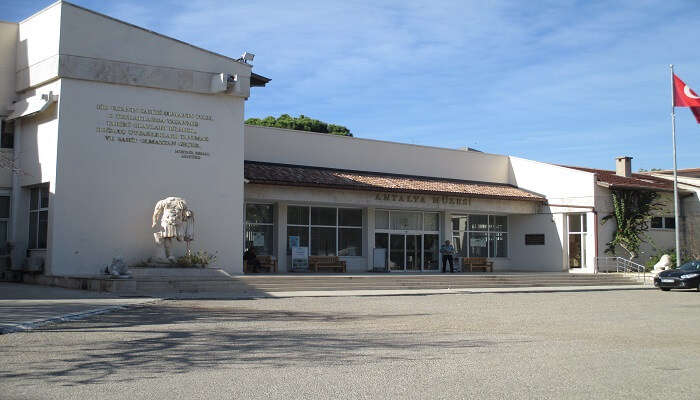
The Antalya Museum in Muratpaşa, Antalya, Turkey, is one of the country’s largest museums. Established in 1922, it houses an extensive collection of artefacts illuminating the history of the Mediterranean and Pamphylia regions in Anatolia. The museum boasts 13 exhibition halls and an open-air gallery. More than 5,000 pieces of art are on display, while another 25,000–30,000 are kept in storage. Interestingly, 1988 it was awarded the “European Council Special Prize.”
Location: Bahçelievler, Konyaaltı Cd. No:88, 07050 Muratpaşa/Antalya, Türkiye
Travel Time: 12 min
3. Duden Waterfalls
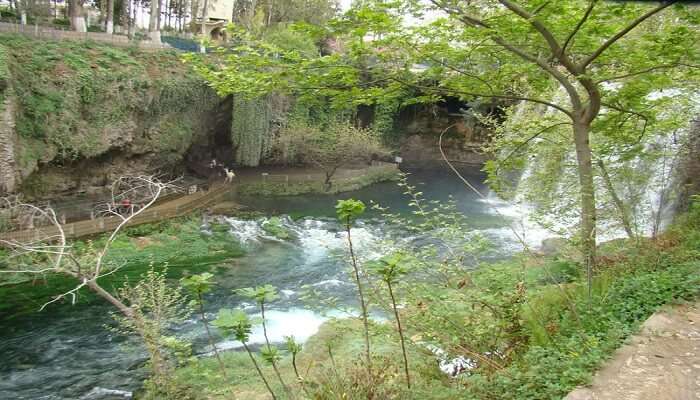
The Duden Waterfalls are a stunning natural attraction in Antalya, Turkey, known for their breathtaking beauty and serene ambience. The Duden River, which comes from the Taurus Mountains, forms two main waterfalls: the Upper Duden Waterfall, located in a peaceful park, and the Lower Duden Waterfall, which dramatically falls into the Mediterranean Sea from cliffs that are 40 meters high. Visitors can explore a cave behind the Upper Falls or enjoy the refreshing mist and rainbows from the spray of the Lower Falls.
Location: Varsak Mahallesi Düden Şelalesi Parkı içi, Kepez/Antalya, Türkiye
Travel Time: 19 min
Further Read: Cruises From Turkey
Hadrian’s Gate is an impressive example of ancient Roman architecture in Turkey. When you visit, you’ll be transported back in time and amazed by its grand design. Don’t pass up the opportunity to see this historical wonder! Book your trip to Turkey today and immerse yourself in the beauty and charm of this enchanting destination!
For our editorial codes of conduct and copyright disclaimer, please click here.
Cover Image Credit: Maksym Kozlenko for Wikimedia Commons
Frequently Asked Questions About Hadrian’s Gate
What is the story of Hadrian's gate?
Originally constructed to honour Roman Emperor Hadrian's visit to Attaleia (as Antalya was then called), the gate dates all the way back to 130 AD. It should come as no surprise that this old building serves as one of the primary entrances to Kaleiçi, the lovely historic neighbourhood of the city.
What is Hadrian most famous for?
Hadrian is famous for building projects throughout the Roman Empire, including Hadrian’s Wall in northern Britain. He was also a supporter of the arts and culture.
How many Hadrians gates are there?
Three arched gates are on it. On her route to see King Solomon, Sultan Belkis, the Queen of Sheba, is reported to have gone through the gates and had a pleasant day in the palace in Aspendos.
How long was Hadrian's rule?
Hadrian ruled from 117 to 138 CE and held the title of Roman Emperor for 21 years.
Why was Hadrian's Gate built?
In 130 CE, Hadrian’s Gate was built in Antalya to honor Emperor Hadrian’s visit and express gratitude for his contributions to the city.
People Also Read:
India Gate Golden Gate Gates of The Arctic National Park

With a passion for travelling, and carving beautiful stories of stunning locations I chose my profession as a content writer. The unique blend of creativity and strategy ensures that each narrative takes readers on a journey to their desired destination. With distinct locations and unique vibes, I strive to deliver captivating content that speaks to the hearts of readers.



